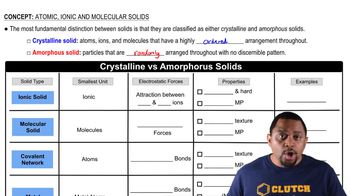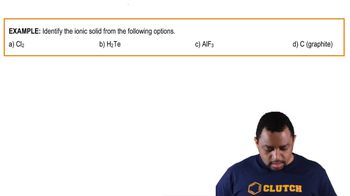Textbook Question
Plonium crystallizes with a simple cubic structure. It has a density of 9.3 g/cm3, a radius of 167 pm, and a molar mass of 209 g/mol. Use these data to calculate Avogadro's number (the number of atoms in one mole).
 Verified step by step guidance
Verified step by step guidance



Plonium crystallizes with a simple cubic structure. It has a density of 9.3 g/cm3, a radius of 167 pm, and a molar mass of 209 g/mol. Use these data to calculate Avogadro's number (the number of atoms in one mole).
Identify each solid as molecular, ionic, or atomic. a. Ru(s)
Identify each solid as molecular, ionic, or atomic. d. Xe(s)
Which solid has the highest melting point? Why? C(s, diamond), Kr(s), NaCl(s), H2O(s)
Which solid in each pair has the higher melting point and why?
a. TiO2(s) or HOOH(s)
b. CCl4(s) or SiCl4(s)
c. Kr(s) or Xe(s)